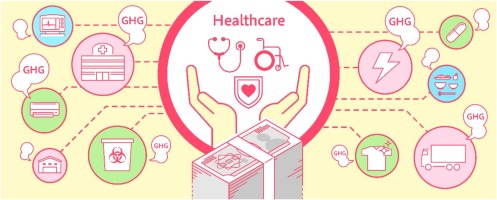We published a new paper from Resources, Conservation and Recycling.
Highlights
・In Japan, the carbon footprint of health care accounted for 4.6% of total national emissions in 2011.
・By 2015, the annual carbon footprint had increased to 72.0 MtCO2e owing to the growth of medical expenditures.
・The carbon footprint per patient with or without hospitalization was 12 and 2.1 tCO2e/y, respectively.
・Avoiding generation of unused medicines can potentially reduce emissions by 1.24 MtCO2e/y.
・To safeguard planetary health, more options for health promotion and carbon emission mitigation need to be provided.
Abstract
The carbon footprint of Japanese health care services, i.e. the domestic greenhouse gas (GHG) emissions caused by health care expenditures, including the associated fixed capital, were calculated using input-output analysis. In 2011 the total carbon footprint of these services was 62.5 × 106 metric tons of CO2 equivalent (MtCO2e), which is 4.6% of total domestic GHG emissions. Medical services involving hospitalization accounted for the greatest share, at 15.7 MtCO2e. The second highest category, Medical services without hospitalization, accounted for only slightly less: 14.2 MtCO2e. However, the difference in emissions per patient between these two categories was considerable. On average, emissions per patient for Medical services (hospitalization) were 12 tCO2e/patient, whereas for Medical services (non-hospitalization) they were only 2.1 tCO2e/patient, or 5.4 times less. In terms of type of medical condition, the greatest annual emissions were associated with cardiovascular disease (6.2 MtCO2e) and neoplasm (4.0 MtCO2e). In terms of age, emissions attributed to patients aged 65 and over accounted for more than half of total health care emissions. By 2015, the total carbon footprint had increased to 72.0 MtCO2e, a rise of over 15% in four years. Although medical care and pharmaceuticals are the main factors responsible for this increase, emissions associated with nursing services have also risen, suggesting that demographic aging may be having a significant impact on GHG emissions. As a countermeasure, the potential annual GHG mitigation achievable through avoidance of unused prescribed medicines resulting in waste was estimated at 1.24 MtCO2e, comparable with the total carbon footprint of home medicines. To safeguard planetary health, in addition to implementing technological improvements to the supply chains of health care services, it will be necessary to provide citizens further options for achieving health promotion and GHG mitigation simultaneously.
Graphical abstract

Keisuke Nansai , Jacob Fry , Arunima Malik , Wataru Takayanagi , Naoki Kondo(2019) Carbon footprint of Japanese health care services from 2011 to 2015.Carbon footprint of Japanese health care services from 2011 to 2015. Resources, Conservation and Recycling 152.
https://doi.org/10.1016/j.resconrec.2019.104525